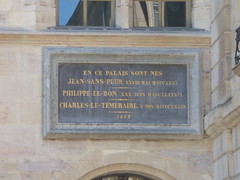

Philip the Good
(1386-1467)
Duke of Burgundy (from 1419)
Died aged 80
Wikidata WikipediaPhilip III (French: Philippe le Bon; Dutch: Filips de Goede; 31 July 1396 – 15 June 1467) was Duke of Burgundy from 1419 until his death. He was a member of a cadet line of the Valois dynasty, to which all 15th-century kings of France belonged. During his reign, the Burgundian State reached the apex of its prosperity and prestige, and became a leading centre of the arts. Philip is known historically for his administrative reforms, his patronage of Flemish artists such as van Eyck and Franco-Flemish composers such as Gilles Binchois, and perhaps most significantly the seizure of Joan of Arc, whom Philip ransomed to the English after his soldiers captured her, resulting in her trial and eventual execution. In political affairs, he alternated between alliances with the English and the French in an attempt to improve his dynasty's powerbase. Additionally, as ruler of Flanders, Brabant, Limburg, Artois, Hainaut, Holland, Luxembourg, Zeeland, Friesland and Namur, he played an important role in the history of the Low Countries.
DbPedia
Commemorated on 1 plaque
En ce Palais sont nes Jean-sans-Peur, XXVIII Mai MCCCLXXI. Philippe-le-Bon, XXX Juin MCCCLXXXVI. Charles-le-Téméraire, X Nov MCCCCXXXIII.
English translation: In this palace were born John the Fearless 28 May 1371, Philip the Good 30 June 1386, Charles the Bold 10 Nov 1433.
Place des Ducs de Bourgogne, Dijon, France where they was born (1386)
